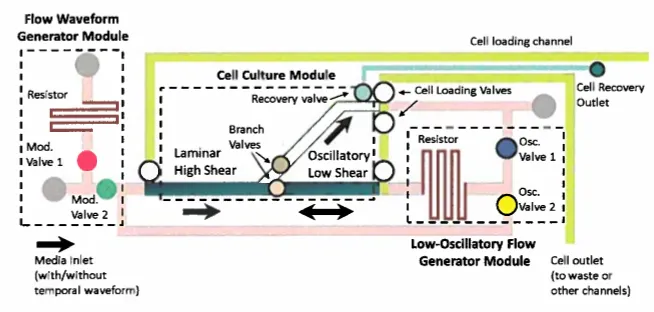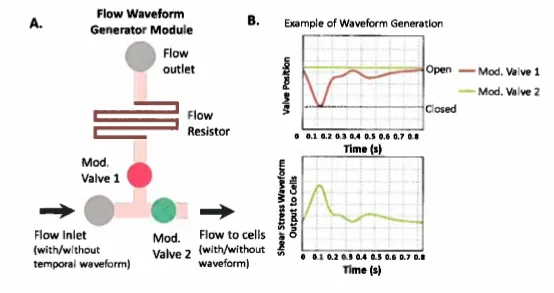Atherofluidics-on-Chip
Atherofluidics-on-Chip can be used to dynamically apply controlled spatio-temporal atheroprotective and atheroprone flow signatures to endothelial cells cultured for vascular diseases research.
Researchers
-
atherofluidics-on-chip
United States of America | Granted | 10,598,166
Figures
Technology
This invention, termed ‘atherofluidics-on-chip,’ consists of a microfluidic chip that can dynamically apply controlled and more relevant spatio-temporal atheroprone and atheroprotective flow patterns to endothelial cells in vitro. It contains atheroprotective and atheroprone regions that can be activated via valves on the chip and can simultaneously apply high shear flow and oscillatory low-shear flow to cells in different compartments. The cells growing in the same monolayer can be exposed to atheroprotective and atheroprone flows in different regions and can be recovered selectively through a channel after the experiment is concluded. Valves on the chip allow for one to dynamically control parameters of the fluid flow pattern, such as its waveform and oscillatory shear index. These valves adjust the flow rate from a flow source, so they rely on an outside power to generate high levels of shear stress. Preliminary results using this technology have confirmed the chip’s ability to generate multiple unique flow profiles and control shear stress and oscillatory shear indices in branches of the device.
Problem Addressed
Many in vitro platforms such as cone-plate viscometers, parallel plate flow chambers, and vertical step flow devices, have been used to apply different hemodynamic flow patterns to primary human epithelial cells growing in fluid to model cardiovascular pathologies, since flow patterns are highly prognostic of diseases such as atherosclerosis. These platforms are usually used to screen for drugs that treat these diseases and are advantageous to in vivo models in that they allow for human cells to be studied directly. However, current in vitro systems cannot replicate the complex flow profiles that exist in vivo. In addition, they usually only allow for a single fluidic condition to be analyzed per experiment. A new device that offers high throughput and a modelling of more complex spatio-temporal flow patterns would greatly improve upon current devices.
Advantages
- Novel solution to study vascular-like flows directly on human cells
- Unique customization of atheroprotective and atheroprone flow profiles
- Inexpensive experimentation due to lower reagent costs and the ability to run parallel experiments at once
- Ability to monitor cells in real time and recover cells from specific flow regions
License this technology
Interested in this technology? Connect with our experienced licensing team to initiate the process.
Sign up for technology updates
Sign up now to receive the latest updates on cutting-edge technologies and innovations.


